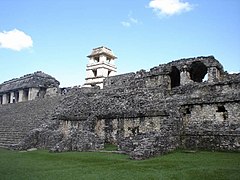Tenejapa-Lacandón Formation
| Tenejapa-Lacandón Formation | |
|---|---|
| Stratigraphic range: Danian, | |
 The city of Palenque was built with stone from the Tenejapa-Lacandón Formation | |
| Type | Unit or geological formation |
| Sub-units | Tenejapa Formation, Lacandón Formation |
| Lithology | |
| Primary | Limestone |
| Other | Marl, breccia |
| Location | |
| Region | Chiapas, Petén |
| Country | Mexico Guatemala |
| Type section | |
| Named for | Tenejapa Municipality, Lacandon Jungle |
| Named by | Vinson, 1962 (Lacandón)
Quezada-Muñetón, 1987 (Tenejapa) Alvarado-Ortega, 2015 (as a combined unit) |
The Tenejapa-Lacandón Formation is a geological formation and lagerstätte in southern Mexico and western Guatemala. It preserves fossils dating to the Early Paleocene.[1][2][3]
It is located primarily in the Mexican state of Chiapas, but outcrops lie as far west as Petén, Guatemala. Some consider it as two distinct formations, the Tenejapa Formation to the west and the Lacandón Formation to the east, which are contiguous and contemporary with each other.[1] The Lacandón Formation was deposited in a shallow inshore marine habitat, whereas the Tenejapa Formation was deposited in a deep offshore habitat.[4] They appear to preserve a marine ecosystem deposited on the western margin of the Caribbean Sea.
The most prominent exposures are at the División del Norte and Belisario Domínguez quarries near Palenque, Chiapas, which contain articulated fish skeletons belonging to a variety of taxa of both Cenozoic and Mesozoic affinities. This formation was also the source of the limestone used to build the ancient Mayan city of Palenque, with one other fossil-bearing locality being an unnamed quarry used by the Mayans. The inhabitants of ancient Palenque were aware of the fossils present in the formation, and used them in ways such as painting articulated fossils for the purpose of decoration.[4]
The Tenejapa-Lacandón Formation is, temporally and geographically, the "closest" geological formation to the Chicxulub impact crater; it is located only 500 kilometres (310 mi) from the Chicxulub crater and was deposited approximately 3 million years after the impact. For this reason, it is important evidence for understanding the recovery of ocean ecosystems in the wake of the Cretaceous-Paleogene extinction event, especially near the Chicxulub crater.[1][5] The high number of well-preserved fossil fish specimens, likely relating to mass mortality events, makes it a lagerstätte.[3] It represents one of the richest known faunas of articulated Paleocene acanthomorphs.[6]
Paleofauna
Fishes
| Genus | Species | Location | Stratigraphic position | Material | Notes | Images |
|---|---|---|---|---|---|---|
| Anguilliformes | incertae sedis | Belisario Domínguez | Multiple complete specimens | An eel.[1] | ||
| Chaychanus | C. gonzalezorum | Belisario Domínguez | Complete specimen | An early damselfish.[7] | ||
| Chanidae | incertae sedis | A relative of the milkfish.[1] | ||||
| Clupeidae | incertae sedis | División del Norte | Complete specimen | A herring relative.[1] | ||
| Eekaulostomus | E. cuevasae | Belisario Domínguez | Complete specimen | An armored relative of the trumpetfish.[8] | 
| |
| ?Erythrinidae | incertae sedis | A potential trahira.[1] | ||||
| Gonorhynchidae | incertae sedis | A relative of the beaked salmon.[1] | ||||
| Kelemejtubus | K. castroi | Belisario Domínguez & División del Norte | Multiple complete specimens | An indeterminate percomorph.[1] | 
| |
| Paleoserranus | P. lakamhae | Belisario Domínguez & División del Norte | Multiple complete specimens | A serranid.[9] | 
| |
| ?Phareodus | P. sp. | División del Norte | Complete specimen | An osteoglossid.[1] Assignment disputed.[10] | 
| |
| Pycnodus | P. sp. | Belisario Domínguez | Multiple complete specimens | A pycnodontid.[1] | 
|
Reptiles
| Genus | Species | Location | Stratigraphic position | Material | Notes | Images |
|---|---|---|---|---|---|---|
| Testudines | incertae sedis | A turtle. |
References
- ^ a b c d e f g h i j k Alvarado-Ortega, J; Cuevas-García, M; Melgarejo-Damián, M; Cantalice, KS.; Alaniz-Galvan, A; Solano-Templos, G; Than-Marchese, B (2015). "Paleocene fishes from Palenque, Chiapas, southeastern Mexico". Palaeontologia Electronica. doi:10.26879/536. ISSN 1094-8074.
- ^ "PBDB". paleobiodb.org. Retrieved 2024-04-12.
- ^ a b Cantalice, Kleyton Magno; Martínez-Melo, Alejandra; Romero-Mayén, Violeta Amparo (2019-08-30). "The paleoichthyofauna housed in the Colección Nacional de Paleontología of Universidad Nacional Autónoma de México". Zoosystematics and Evolution. 95 (2): 429–452. doi:10.3897/zse.95.35435. ISSN 1860-0743.
- ^ a b Alvarado-Ortega, Jesús; Cuevas-García, Martha; Cantalice, Kleyton (2018-02-01). "The fossil fishes of the archaeological site of Palenque, Chiapas, southeastern Mexico". Journal of Archaeological Science: Reports. 17: 462–476. doi:10.1016/j.jasrep.2017.11.029. ISSN 2352-409X.
- ^ Cantalice, Kleyton M; Alvarado-Ortega, Jesús; Bellwood, David R; Siqueira, Alexandre C (2022-07-20). "Rising from the Ashes: The Biogeographic Origins of Modern Coral Reef Fishes". BioScience. 72 (8): 769–777. doi:10.1093/biosci/biac045. ISSN 0006-3568. PMC 9343231. PMID 35923187.
- ^ Friedman, Matt; V. Andrews, James; Saad, Hadeel; El-Sayed, Sanaa (2023-06-16). "The Cretaceous–Paleogene transition in spiny-rayed fishes: surveying "Patterson's Gap" in the acanthomorph skeletal record André Dumont medalist lecture 2018". Geologica Belgica. doi:10.20341/gb.2023.002. ISSN 1374-8505.
- ^ Cantalice, Kleyton Magno; Alvarado-Ortega, Jesús; Bellwood, David Roy (2020). "†Chaychanus gonzalezorum gen. et sp. nov.: A damselfish fossil (Percomorphaceae; Pomacentridae), from the Early Paleocene outcrop of Chiapas, Southeastern Mexico". Journal of South American Earth Sciences. 98: 102322. doi:10.1016/j.jsames.2019.102322. ISSN 0895-9811.
- ^ Cantalice, K. M.; Alvarado-Ortega, J. (2016). "Eekaulostomus cuevasae gen. and sp. nov., an ancient armored trumpetfish (Aulostomoidea) from Danian (Paleocene) marine deposits of Belisario Domínguez, Chiapas, southeastern Mexico". Palaeontologia Electronica. doi:10.26879/682. ISSN 1094-8074.
- ^ Cantalice, Kleyton M.; Alvarado-Ortega, Jesús; Alaniz-Galvan, Abril (2018). "Paleoserranus lakamhae gen. et sp. nov., a Paleocene seabass (Perciformes: Serranidae) from Palenque, Chiapas, southeastern Mexico". Journal of South American Earth Sciences. 83: 137–146. doi:10.1016/j.jsames.2018.01.010. ISSN 0895-9811.
- ^ Capobianco, Alessio; Foreman, Ethan; Friedman, Matt (2021). Cavin, Lionel (ed.). "A Paleocene (Danian) marine osteoglossid (Teleostei, Osteoglossomorpha) from the Nuussuaq Basin of Greenland, with a brief review of Palaeogene marine bonytongue fishes". Papers in Palaeontology. 7 (1): 625–640. doi:10.1002/spp2.1291. hdl:2027.42/167033. ISSN 2056-2799.
